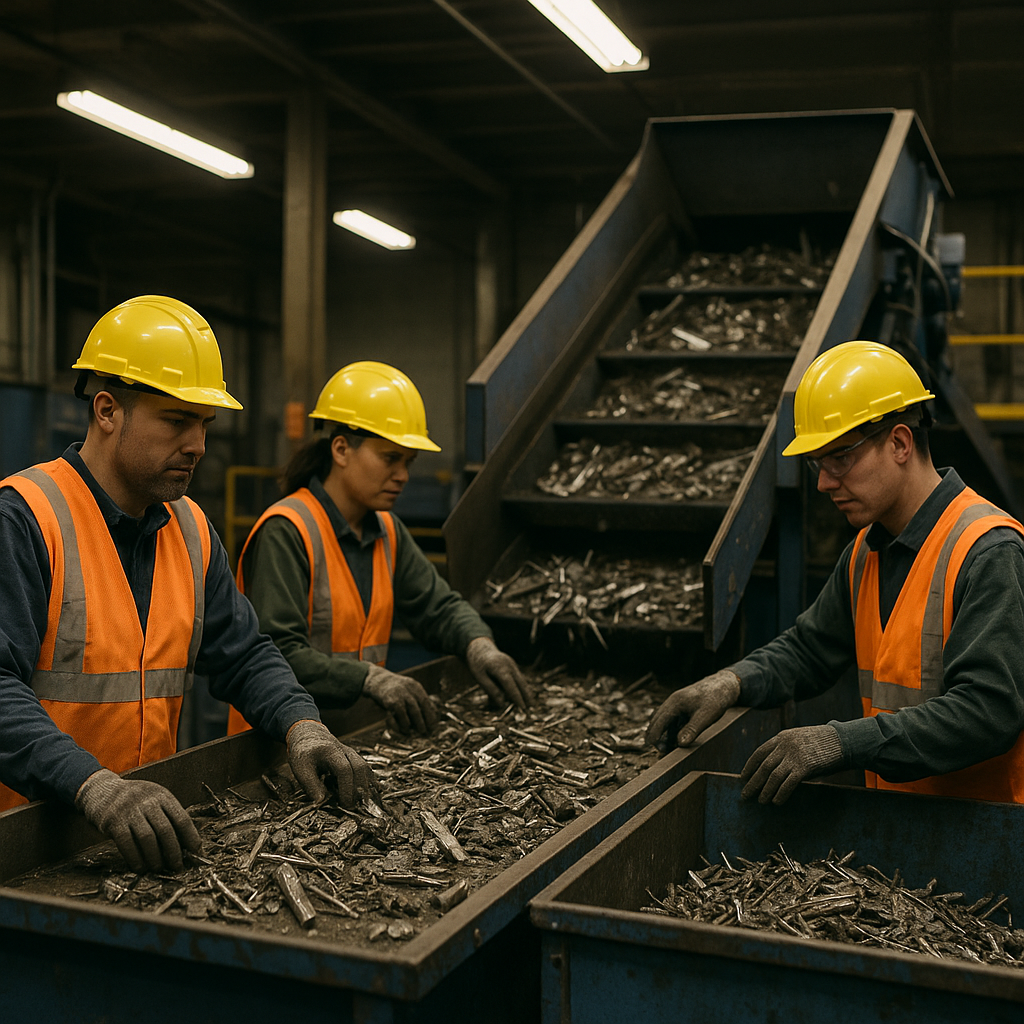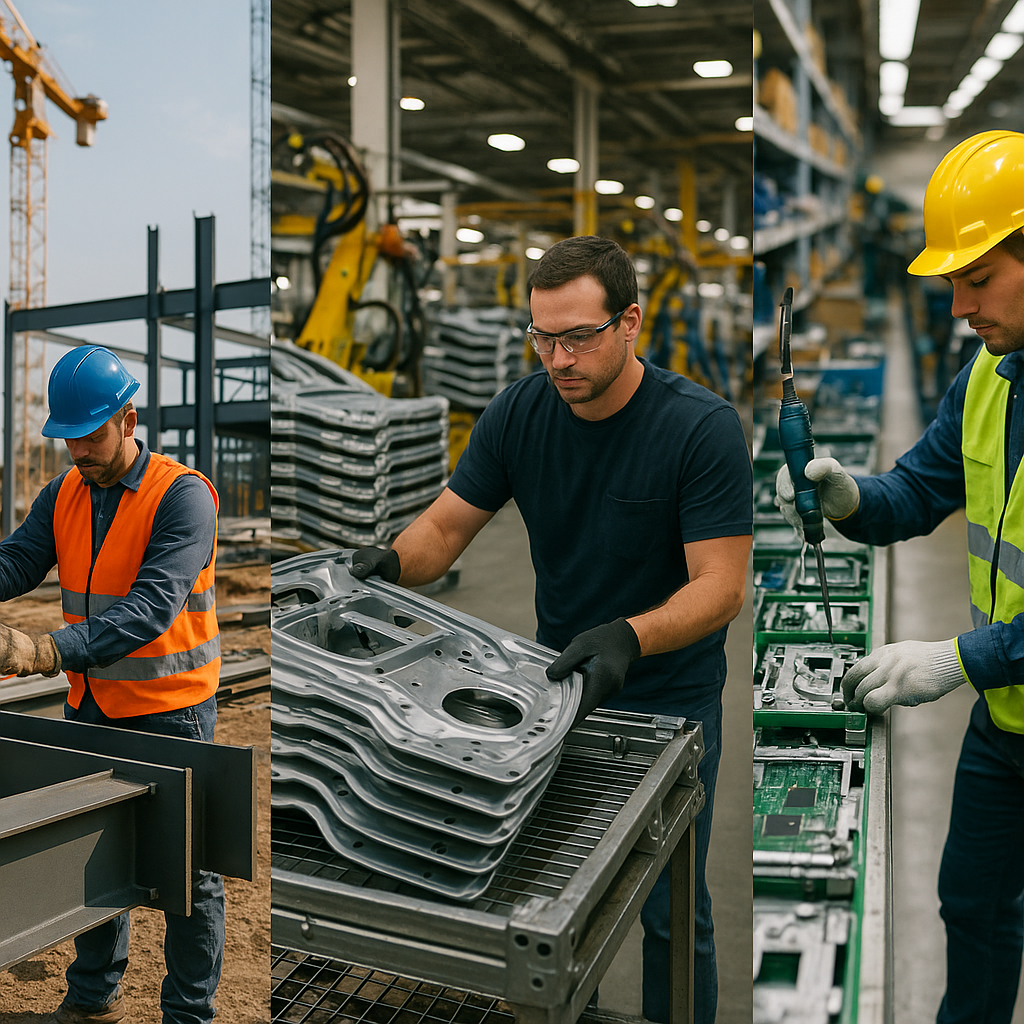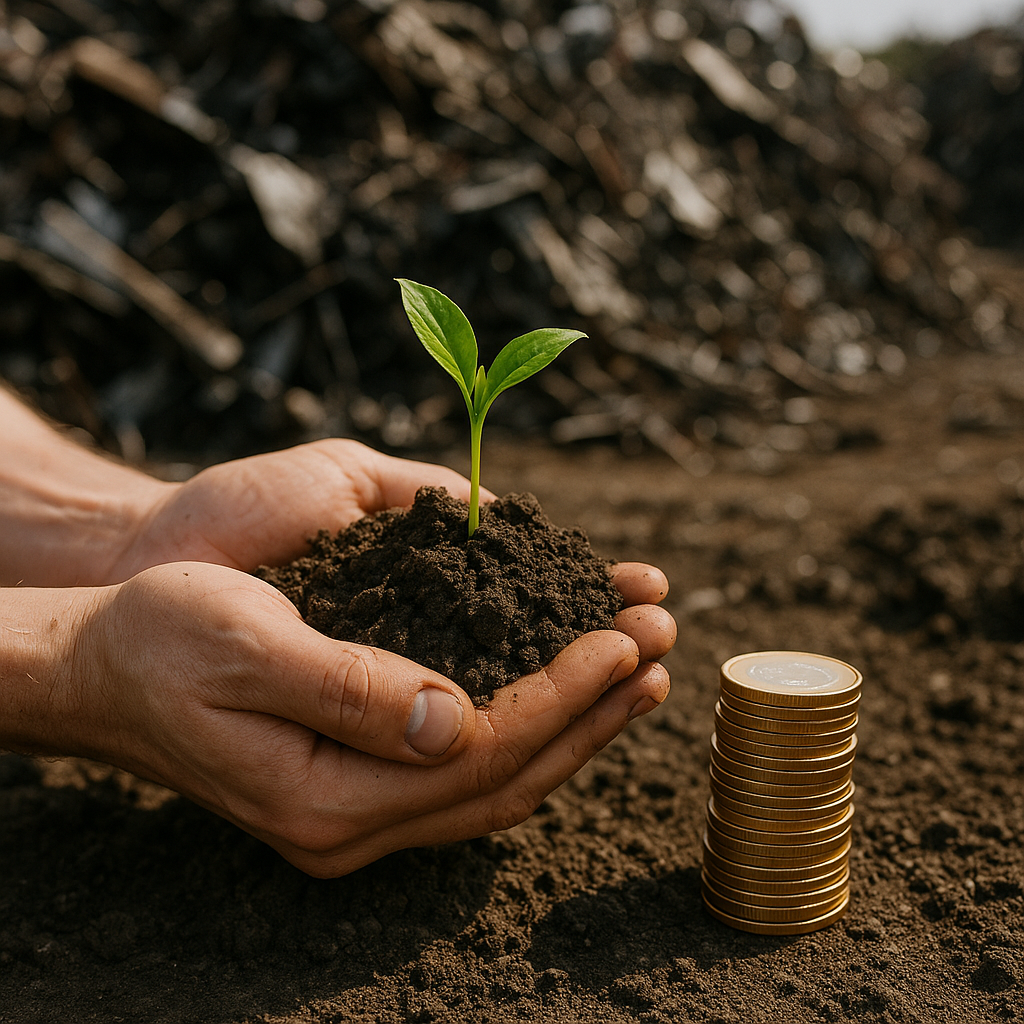5901 Botham Jean Blvd, Dallas, TX 75215
Scrap Processing: Steps, Benefits, Industry Impact, and Future Trends
September 27, 2025Scrap processing transforms discarded metal waste into valuable raw materials for manufacturing. This essential recycling practice recovers metals from various sources and prepares them for reuse in new products. The metal recycling industry is crucial for fostering a more sustainable economy while providing significant environmental and economic benefits.
The process begins with collecting metal waste from homes, businesses, demolition sites, and manufacturing facilities. These materials, otherwise destined for landfills, are sorted by type, processed into manageable pieces, melted down, purified, and eventually transformed into new raw materials. Each step is designed to maximize resource recovery while minimizing environmental impact.
Scrap processing offers considerable advantages over traditional mining and refining of virgin metals. It conserves natural resources, requires significantly less energy, reduces greenhouse gas emissions, and decreases waste in landfills. For businesses, it provides a cost-effective source of raw materials and helps meet sustainability goals in an increasingly environmentally conscious marketplace.
What Are the Key Steps in Scrap Metal Processing?

Scrap metal processing transforms discarded metal materials into valuable resources through a series of well-defined stages. Each step is crucial to ensure the final recycled product meets quality standards while maximizing resource recovery.
Collection
The process begins with gathering scrap metal from various sources such as industrial facilities, construction sites, demolition projects, and household items. Collection methods range from curbside pickup programs to dedicated drop-off points at recycling centers. This initial stage is vital as it diverts metal waste from landfills and directs it into the recycling stream.
Many recycling facilities collaborate with businesses, municipalities, and individuals to establish efficient collection systems that maximize metal recovery rates. The collected materials include everything from aluminum cans and copper wiring to large steel structures and automotive parts.
Sorting
Once collected, scrap metal is carefully sorted based on type and composition. This critical phase ensures that different metals are processed according to their specific properties.
Modern sorting facilities employ several technologies for accurate separation:
- Magnetic separators distinguish ferrous (iron-containing) from non-ferrous metals.
- Eddy current separators repel non-ferrous metals like aluminum.
- XRF (X-ray fluorescence) devices identify metal composition with precision.
- Manual inspection by trained operators for quality control.
Proper sorting maximizes the value of recovered materials and ensures efficient processing in subsequent stages.
Processing and Shredding
Before melting, scrap metal must be reduced to manageable sizes. This involves cutting, crushing, and shredding to transform bulky items into smaller pieces.
Hydraulic machinery plays a crucial role in this stage, powering equipment such as:
- Industrial shears that cut through thick metal components.
- Balers that compress materials into dense blocks.
- Shredders that reduce scrap to uniform fragments.
Size reduction increases surface area for more efficient melting, facilitates transport between stages, and helps remove non-metallic components.
Melting
The processed scrap enters specialized furnaces designed for specific metal types. Steel requires different melting conditions than aluminum or copper, so recycling facilities often have multiple furnace types for various materials.
During melting, the scrap turns molten, allowing for material homogenization. This stage requires precise temperature control and monitoring to ensure proper melting while minimizing energy consumption. Melting recycled metal typically uses significantly less energy than processing virgin ore.
Purification
Molten metal often contains impurities that must be removed to meet quality standards. Purification techniques vary by metal type but commonly include:
- Slag removal, where unwanted materials float to the surface for skimming.
- Chemical treatments that bind with specific impurities.
- Electrolysis for high-purity applications, especially with non-ferrous metals.
- Gas injection that helps separate certain contaminants.
This stage is crucial for ensuring the recycled metal maintains the necessary properties for its intended uses. The level of purification depends on end-use requirements, with some applications demanding extremely high purity levels.
Solidification and Manufacturing
In the final stage, purified molten metal cools and solidifies into standardized forms for manufacturing, such as ingots, billets, or sheets, depending on future use.
The solidified metal undergoes quality testing to verify its properties before being shipped to manufacturers, completing the recycling loop as the metal is ready to begin its new lifecycle.
Through these systematic steps, scrap metal processing diverts valuable materials from waste streams and returns them to productive use with a significantly reduced environmental impact compared to mining and refining virgin resources.
How Does Scrap Processing Impact Different Industries?

Scrap processing is crucial for metal recycling across many industries, with recycled metals accounting for a substantial portion of manufacturing materials in the United States. Currently, over 80% of aluminum, 70% of steel, 78% of lead, and 35-40% of copper used in American manufacturing come from recycled sources.
The automotive sector significantly benefits from scrap processing. In the US, scrap processors handle over 56 million tons of iron and steel annually, including 10 million tons from end-of-life vehicles. The industry’s shift towards sustainability has made automotive manufacturers more reliant on recycled materials, especially as vehicle designs increasingly feature aluminum for lighter construction.
The construction industry has similarly embraced recycled metals. Steel beams, aluminum siding, copper wiring, and other metal components recovered through scrap processing reduce reliance on virgin materials in building projects. This not only conserves natural resources but also decreases the energy consumption associated with new metal production. Recycled steel requires about 74% less energy to produce than its virgin counterpart, resulting in significant cost savings and environmental benefits.
Electronics manufacturing is another sector heavily influenced by scrap processing. As consumer electronics become more disposable, recovering precious and rare-earth metals from discarded devices is increasingly crucial. Circuit boards contain gold, silver, platinum, and copper that can be extracted and reintroduced into the supply chain, minimizing the environmental impact of mining and ensuring a steady supply of these valuable materials.
The renewable energy sector also relies more on recycled metals. Solar panels, wind turbines, and energy storage systems require substantial amounts of aluminum, copper, and other metals. By incorporating recycled content, manufacturers can reduce the carbon footprint of these green technologies, enhancing their sustainability credentials.
Industrial manufacturing benefits from scrap processing through stabilized material costs. Recycled metals often buffer against the price volatility common in raw material markets. This predictability enhances financial planning and risk management, particularly for operations with narrow profit margins. Additionally, the domestic nature of scrap processing improves supply chain resilience by reducing dependence on imported raw materials.
The circular economy concept has gained traction across these industries, with scrap processing serving as a critical link. Instead of the traditional linear model of take-make-dispose, businesses now participate in a system where materials retain their value through multiple life cycles. In the US, this circular approach to metal usage contributes over $105 billion in economic activity annually and supports nearly half a million jobs throughout the recycling supply chain.
What Are the Environmental and Economic Benefits of Scrap Processing?
Environmental Advantages of Scrap Processing
Scrap processing plays a crucial role in resource conservation. By recycling metals, we reduce our dependence on extracting virgin materials through mining, helping preserve natural resources. For example, recycling one metric ton of steel saves 1.1 metric tons of iron ore, 630 kilograms of coal, and 55 kilograms of limestone.
The energy savings from scrap processing are significant. Using recycled materials to produce metals requires less energy than using virgin ore. Aluminum recycling saves up to 95% of the energy needed for primary production, while steel recycling conserves about 74% of the energy required to make new steel from raw materials.
Greenhouse gas emissions are significantly reduced by scrap processing. The US Environmental Protection Agency states that recycling one ton of steel can cut greenhouse gas emissions by 2.1 metric tons of carbon dioxide equivalent. These reductions help mitigate climate change and improve local air quality.
Scrap processing also decreases waste. Materials that might otherwise end up in landfills are reused through recycling, helping communities maintain cleaner environments and minimizing the environmental impact of waste management.
Economic Impact of Scrap Processing
Scrap processing offers significant economic benefits both locally and nationally. The U.S. scrap recycling industry generates nearly $109.78 billion annually, accounting for about 0.54% of the nation’s total economic activity, comparable to the warehousing and storage industry.
Job creation is a key economic benefit, with the industry supporting over 500,000 jobs across various skill levels. These include roles like collection specialists, truck drivers, processing facility workers, and administrative staff. Many of these jobs provide competitive wages and benefits, offering stable employment opportunities nationwide.
Using recycled materials lowers manufacturing costs. Recycled metals reduce the need for costly mining and extraction processes, allowing manufacturers to offer more competitive pricing both domestically and internationally, thus creating a more sustainable supply chain.
The industry also makes significant contributions to tax revenues, with scrap recyclers generating more than $4.4 billion in state and local taxes each year. These funds support essential public services, such as schools, roads, and emergency response systems, further boosting local economies.
| Aspect | Virgin Metal Production | Recycled Metal Production |
|---|---|---|
| Energy Consumption | High (e.g., 6.0 MJ per ton for steel) | 60-95% less energy required |
| Environmental Impact | Significant impact due to mining (deforestation, pollution) | Significantly reduced, less pollution |
| Cost | $920 per metric ton (steel) | $415 per metric ton (steel) |
| Quality | High | Equally high; retains properties |
| Supply Chain | Dependent on mining operations | Stable, reduces dependency on imports |
Supply Chain Resilience Through Scrap Processing
Scrap processing enhances stability in manufacturing supply chains. About 70% of recyclables processed in the U.S. are used domestically, feeding steel mills, aluminum smelters, copper and brass mills, and other manufacturers. This domestic consumption decreases reliance on international sources that might face disruptions.
Scrap metal recycling also stabilizes fluctuating commodity prices by providing a consistent material source. This stability boosts resource security and strengthens national economic resilience during global market uncertainties.
Access to recycled materials enhances global competitiveness for manufacturers. With international shipping experiencing delays or increased costs, businesses that rely on local recycled materials gain a competitive edge, sustaining production capacity and protecting jobs during supply chain disruptions.
The circular economic model fostered by scrap processing benefits everyone involved. Individuals earn additional income, businesses cut costs and enhance their sustainability credentials, and communities see increased employment and reduced environmental impacts. This strengthens the economic cycle as recycling technology and processes advance.
What Challenges and Future Trends Exist in Scrap Processing?

The scrap processing sector faces significant challenges while adopting transformative technologies that are reshaping its future. Understanding these obstacles and emerging trends helps stakeholders adapt to changes in recycling and resource recovery.
Current Challenges in Scrap Processing
Despite its environmental and economic benefits, scrap processing encounters several obstacles. Material contamination is a persistent issue; when different metals or non-metals are mixed during collection, it can compromise recycling quality and reduce the value of recovered materials. For example, trace amounts of copper mixed with steel can affect the properties of recycled steel, making quality control essential.
Market volatility presents another major challenge. Scrap metal prices fluctuate due to global demand, trade policies, and economic conditions, which leads to financial uncertainty and affects business planning. Additionally, increasing complexity in product design complicates separation and processing, as modern devices contain intricate combinations of materials that require specialized techniques.
Regulatory compliance further adds to the complexity. As environmental regulations evolve, scrap processors must invest in new equipment and procedures to meet standards for emissions, waste handling, and safety, posing challenges for smaller operations with limited resources.
Technological Innovations in Scrap Processing
Advanced automation is driving innovation in scrap processing. AI-powered sorting systems and robotics are improving material identification and separation. These technologies accurately distinguish metal types, enhancing recovery rates and reducing labor costs. Smart sensors and machine learning algorithms enable real-time equipment performance monitoring, optimizing operations and minimizing downtime.
Improved sorting technologies have significant impacts too. X-ray fluorescence (XRF) and laser-induced breakdown spectroscopy (LIBS) can precisely identify metals, even when mixed with other materials. This is valuable for recovering high-value metals from complex waste streams.
Processing techniques are also advancing. Hydrometallurgical methods using chemical solutions, rather than heat, allow for more efficient recovery of precious and rare metals from electronic waste. These methods often use less energy than traditional smelting and can target specific metals more precisely.
Urban Mining: Harnessing Above-Ground Resources
Urban mining represents a promising development in scrap processing. This concept views cities as above-ground mines, extracting valuable metals from discarded products, obsolete infrastructure, and electronic waste. Smartphones alone contain over 60 elements, including precious metals like gold and silver, and rare earth elements critical for modern technologies.
The focus on urban mining is timely as natural resources face mounting pressure. Electronic waste, in particular, is a rich source of recyclable materials. A single ton of smartphones contains more gold than a ton of ore from a gold mine. As electronic waste volume grows, urban mining will be crucial in meeting the demand for critical metals.
Cities are implementing innovative collection systems to capture these materials before they reach landfills. Specialized recycling facilities are being developed to handle electronic waste, recovering not just common metals like copper and aluminum, but also rare earth elements used in electronics, renewable energy technologies, and electric vehicle components.
The Circular Economy and Scrap Processing
The circular economy model is reshaping industries’ resource use, with scrap processing playing a pivotal role. Product-as-service models, where manufacturers retain material ownership throughout a product’s lifecycle, are gaining traction, encouraging companies to design products for recycling and ensuring materials return to processors at end-of-life.
Design for recycling is increasingly common across sectors. Manufacturers are simplifying product composition and making components easier to separate, streamlining recycling. Some electronics manufacturers are designing products with modular components that can be easily removed and replaced, extending product life and making recycling more effective.
Blockchain technology is enhancing transparency across the recycling supply chain, allowing for improved tracking of materials from collection through processing to eventual reuse, combating fraud, and ensuring ethical sourcing of recycled materials.
Conclusion: The Future of Scrap Processing
Scrap processing is a cornerstone of sustainable manufacturing and resource management in today’s evolving circular economy. We have discussed how scrap processing transforms waste materials into valuable resources, significantly reducing environmental impact while creating economic opportunities. The industry’s ability to conserve energy, minimize carbon emissions, and divert materials from landfills makes it essential for the transition to a more sustainable future.
As innovations like AI-powered sorting systems and advanced recovery techniques continue to emerge, scrap processing will become increasingly efficient and effective. These advancements, along with growing environmental awareness and regulatory support, position the scrap processing industry at the forefront of circular economy initiatives worldwide. For businesses and municipalities aiming to enhance their sustainability efforts and potentially reduce costs, professional recycling solutions are within reach.
Contact Okon Recycling at 214-717-4083 for expert guidance on implementing effective scrap processing practices that benefit both your operations and the environment.
